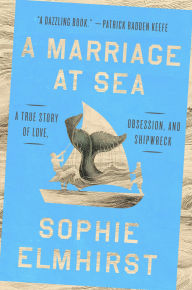Marriage and Survival: A Guest Post by Sophie Elmhirst
Part love story, part peril on the high seas, this is a harrowing true story of near-tragedy and discovering what it really means to find yourself in another. Read on for an exclusive essay from author Sophie Elmhirst on writing A Marriage at Sea.
A Marriage at Sea: A True Story of Love, Obsession, and Shipwreck
A Marriage at Sea: A True Story of Love, Obsession, and Shipwreck
In Stock Online
Hardcover
$25.00
$28.00
The electrifying true story of a young couple shipwrecked at sea: a mind-blowing tale of obsession, survival, and partnership stretched to its limits.
The electrifying true story of a young couple shipwrecked at sea: a mind-blowing tale of obsession, survival, and partnership stretched to its limits.
In truth, I got lucky. I stumbled across Maurice and Maralyn’s story while researching an article about people trying to escape the land and live at sea. On a website devoted to castaways and shipwrecks, a photograph of Maralyn caught my eye – a rare woman among a gallery of wild-looking lone men. I immediately wanted to know who she was, and how she and Maurice had come to be adrift in the Pacific ocean for nearly four months. Inevitably, I was hooked by the drama and sheer improbability of what they’d endured. Their survival seemed so unlikely – week after week spent cramped in a tiny raft, subsisting on raw fish and turtle flesh, watching seven ships sail past without seeing them. But I wasn’t yet sure that their story was worthy of a book. The extremity was intoxicating but somehow not enough. I needed to examine this pair more closely – to understand them as individuals and their dynamic as a couple. A book would only work, I felt, if it could take the reader inside their marriage and tell a more intimate and complex story than one concerned only with events.
There is a version of this story that ends with Maurice and Maralyn’s rescue: a neater, more heroic, happy-ending version. But this didn’t interest me as much as the long, messy reality of their lives. I wondered what the aftermath of such an extreme ordeal would be like; the shadow it might cast over the rest of their existence. Much later in life, Maurice wrote a series of letters to a friend, reflecting on their time adrift. In these, he seemed to throw himself open, more confessional and self-questioning about their experience than he had ever been at the time. The letters gave me access to Maurice’s mind and heart, and offered a profoundly intimate perspective on his marriage. Ultimately, they allowed me to write the kind of book I wanted to write.
A funny side-effect of writing a book about a marriage is how willing people are to tell you about theirs. Something in the story of Maurice and Maralyn seems to prompt readers to examine themselves and their relationships, wondering how they would fare in a shipwreck, how they or their partner would respond to such a crisis, or whether they’d drive each other crazy before they’d even worked out how to fish. I had the same (not wildly hopeful) conversations with my husband, but I have loved listening to the frantic scenario planning and doomy thought experiments of other couples. They have reminded me, too, that while writing can seem like a strange and solitary endeavor, a reader can turn a book into a conversation and make you see your own work afresh.
